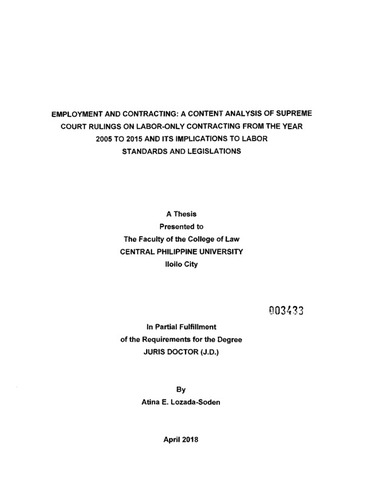Employment and contracting: A content analysis of Supreme Court rulings on labor-only contracting from the year 2005 to 2015 and its implications to labor standards and legislations

Page views
19,624Date
2018Auteur
Thesis Adviser
Defense Panel Chair
Share
Metadata
Afficher la notice complète
Résumé
This study was conducted to analyze the Supreme Court rulings on labor-only contracting from the year 2005 to 2015 and its implications to the labor standards and legislations. Content analysis was employed and the qualitative research design was utilized. From a total of 38 Supreme Court rulings on labor-only contracting from the year 2005 to 2015, a sample of 34 was obtained using the stratified random sampling with a margin error of 0.10. The cases reported by the Supreme Court on secondary data served as the main source for data collection.
Results of the study showed that the four-fold test is traditionally used by the Supreme Court in determining the existence of employer-employee relationship wherein the right to control is the most determinative. The employment relationship is different from contracting. An independent contractor has a business adequately capitalized and lawfully operating; independent from the principal; and management control and supervision of its employees. Contracting out is a valid exercise of management prerogative. In contracting out jobs, the management must be motivated by good faith.
The law allowed contracting but these activities are strictly regulated for the protection of the workers. A person is engaged in labor-only contracting if supplied workers to an employer and the workers recruited and placed are performing activities which are directly related to the principal business of such employer and that principal has the control over the conduct of the work or services performed by the employees of the contractor. The finding that a contractor is a labor-only contractor is equivalent to declaring that an employer-employee relationship exists between the principal and the employees of the labor-only contractor. The principal became solidarily liable with the labor-only contractor for all the rightful claims of the employees. Labor-only contracting is prohibited under the law. Labor-only contracting is exposed through a complaint-and-hearing process resulting in a decision by a competent authority. Without such authoritative decision, the arrangement proceeds as though it were legitimate contracting. Thus, the Supreme Court rulings directly helped in addressing the problem of misunderstanding the Labor Code provisions on contracting as well as protection of labor sectors.
Description
Abstract only
Suggested Citation
Lozada-Soden, A. E. (2018). Employment and contracting: A content analysis of Supreme Court rulings on labor-only contracting from the year 2005 to 2015 and its implications to labor standards and legislations (Unpublished postgraduate thesis). Central Philippine University, Jaro, Iloilo City.
Type
ThesisSujet
Department
College of LawDegree
Juris DoctorShelf Location
Law Library 340.72 L959 2018
Physical Description
xvi, 119 leaves
Collections
- Juris Doctor [144]
Les fichiers de licence suivants sont associés à ce document :


